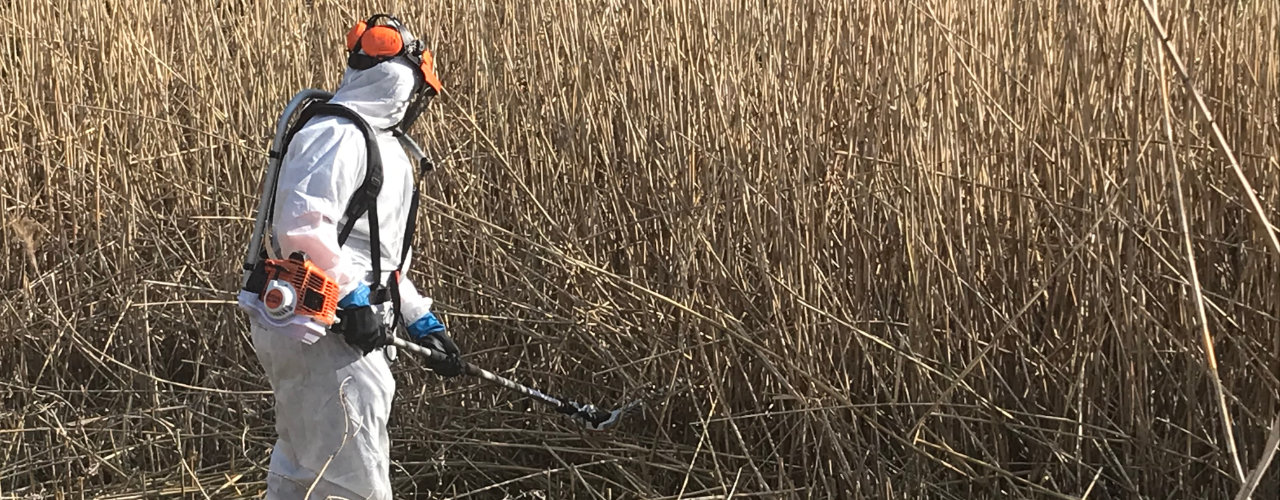It’s important to remember that regular maintenance is crucial for any reed bed to work – whether it’s a natural or engineered reed bed. This is because reed beds play a critical role in the water treatment process.
The Oren Environmental team is on a mission to help educate the industry about the importance of taking care of reed beds and the benefits that come from looking after them.
Alastair Pentland, Environmental Operations Manager at Oren Environmental, said:
“I think that because reed beds are situated in the natural environment, they can often be overlooked and their role underestimated. Not only do they prevent water courses from pollution, but they also provide a home to countless plants and species.”
Different types of reed beds
There are different types of reed beds, and a reed bed plays multiple roles.
Some reed beds are man-made constructed wetlands that exist to serve a purpose. For example, to treat sewage or trade effluent. In the case of our work for the Coal Authority, reed beds are used to treat water from disused coal mines by removing the iron oxide to prevent it from polluting nearby watercourses and harming ecosystems.
Other reed beds act as a water retention basin by absorbing excess water during periods of heavy rainfall, helping to reduce the risk of flooding.
One of the most critical roles a reed bed has is to provide important habitats for a diverse range of flora and fauna – and wildlife, including birds, insects, amphibians, and small mammals. Reed beds offer nesting grounds and shelter for various species.
Reed beds also make a positive economic contribution to society, attracting tourists, birdwatchers, and walkers to sites where reed beds feature.
The role of the reed bed in water treatment
To make the case for reed bed maintenance, it’s helpful to understand the basic mechanics of how they work.
Reed beds are nature’s filtration system. They do the final bit of ‘polishing’ before treated wastewater is discharged into the environment.
When it comes to treating sewage, the wastewater will have already been through primary treatment processes to remove solids. It then enters the reed bed through a piped inlet distribution. The reed bed will be lined with either a natural clay basin or a high-density polyethene geomembrane liner that acts as a barrier to groundwater. A gravel media, also known as substrate, supports the planting of the reeds. The common reed (Phragmites australis) brings oxygen into the base of the reed bed, creating an environment that promotes the growth of bacteria. These bacteria break down waste contaminants in the wastewater, resulting in clean water, which is discharged into a nearby watercourse.
The issue with failing to maintain reed beds
When reed beds fail to treat wastewater, there are water quality risks. This can lead to pollution, which in turn can cause environmental harm, health risks, heavy fines from the regulator, and reputational damage.
A reed bed’s effectiveness is underpinned by an even distribution of water flowing through it, allowing the wastewater to be retained for long enough to be properly purified.
Excess vegetation around a reed bed – like leaves from overhanging trees – can block pipes, affecting the free flow of wastewater through the reed bed.
The reeds themselves need to be cut regularly to maintain a constant source of oxygen in the bed to fuel the bacteria needed to break down sewage. Equally, if the nitrates, ammonium, and phosphates in the sewage aren’t broken down properly, they themselves can become detrimental pollutants and emit harmful greenhouse gases, including methane, carbon dioxide, and nitrous oxide.
Alastair added:
“Routine maintenance processes, including periodic cleaning to remove excess organic matter or debris, are vital to prevent clogging and maintain optimal conditions for bacterial function.
“Maintaining reed beds is not just about preserving nature; it’s about securing a healthier future for our ecosystems and our communities. By recognising the importance of these habitats and actively working towards their preservation, we can reap the multitude of benefits they provide – from pristine water quality to thriving biodiversity and sustainable economic development.”
For more information about Oren Environmental, please visit the Oren Environmental section of our website.
About Oren Environmental
Oren Environmental is an industry leader in reed bed maintenance and large-scale desludging
Our expertise comes from refurbishing and maintaining one of the largest portfolios of reed beds and settlement lagoons in the UK.










